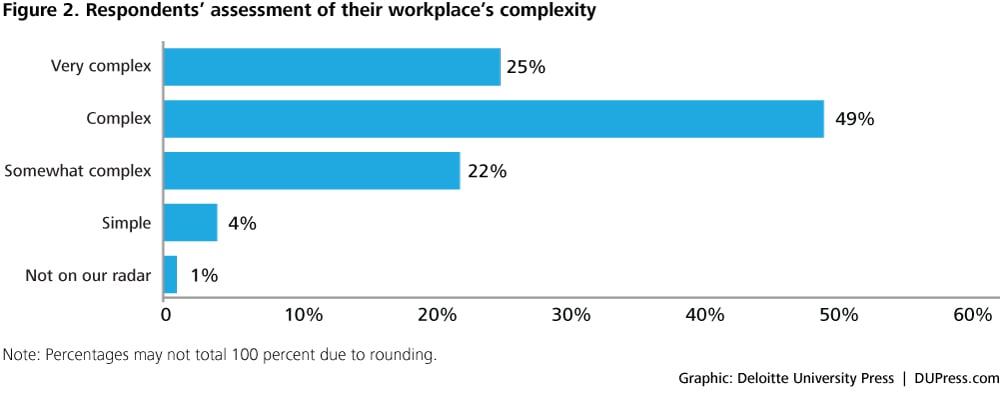Simplification of work has been saved

Simplification of work The coming revolution
28 February 2015
- Burt Rea
Work simplification is one response to employees overwhelmed by increasing organizational complexity, information overload, and a 24/7 work environment.
- Organizations are simplifying work in response to employees becoming overwhelmed by increasing organizational complexity, growing information overload, and a stressful 24/7 work environment.
- More than 7 out of 10 surveyed organizations rated the need to simplify work as an “important problem,” with more than 25 percent citing it as “very important.” Today, only 10 percent of companies have a major work simplification program; 44 percent are working on one.
- Design thinking, work redesign, and technology replacement are becoming critical programs for HR and business leaders seeking to simplify work practices and systems.
View the complete Global Human Capital Trends 2015 series
Explore
Explore the interactive trends dashboard
Learn more about simplification of work
Create and download a custom PDF of the Human Capital Trends 2015 report.
Last year’s Global Human Capital Trends chapter on “the overwhelmed employee” became one of the most popular articles Deloitte has ever published—a sign that the phenomenon was hitting organizations even faster and harder than we thought.1 The capability gaps we observed with regard to the simplification of work (figure 1) reinforce the importance of the issue of the overwhelmed employee. In this year’s research, we explored if organizations were doing anything to address this concern.
Consider some data: In one day more than 100 billion emails are exchanged, yet only one in seven is critically important.2 The average employee now spends over one-quarter of the workday reading and answering emails.3 People now check their mobile phones more than 150 times a day.4 And a new study by the National Journal found that 40 percent of workers believe it is not possible to succeed at work, make a good living, and have enough time to contribute to family and community.5
There are many reasons for work overload: always-on technology, global 24/7 demands, and the proliferation of messaging and social tools we have at our fingertips. But another important driver is complexity in work practices, business processes, and jobs. In this year’s survey, 74 percent of all respondents (including those at small companies) rated their work environment as either “complex” or “highly complex” (figure 2).

We see five primary drivers for this trend:
- Pervasive technology and connectivity: Life, family, and work are all blending together as our mobile devices deliver constant access to work information. While filtering and sorting tools are coming, most employees are flooded with too much random information. By nature, people become addicted to this stimulus, feeding a vicious cycle of “always feeling like we’re at work.”6
- Complexity in technology: New technology features arrive faster than most people can learn to use them. The ever-increasing focus on technology for the sake of technology has come to an end: The simplest products are the ones now most widely used. HR software buyers today want systems with fewer features and less complexity, not more.7 Yet simplification for users at the front end usually adds complexity at the back end when multiple systems are combined.
- Globalization: Most companies, even small businesses, have clients, partners, and suppliers around the world. Projects, conference calls, meetings, and emails happen at all hours of the day and night.
- Increased administrative and compliance demands: Workers worldwide face increasing administrative and compliance headaches that demand time and engagement. Deloitte Australia found that 1 out of 11 people in Australia now works in a compliance role—more than are employed in the country’s entire mining industry.8One bank noted that its compliance costs tripled to $265 million in the last three years, in part due to the need to file 3,150 reports totaling 80,000 pages.
- Overly complex business processes and systems: Business and HR processes have become too complex. Adobe found that its performance management process was so complex it took almost 1.8 million person-hours per year to complete.9 A large manufacturer reported that more than 4,000 different tasks, rules, compliance processes, and procedures were required to build one of its major products.10
Happily, change is coming. From IDEO’s redesign of the shopping cart to transformations brought about by Uber, AirBnB, and Open Table, whole industries are being rocked by dynamic technological and design innovations aimed at simplifying the way we live. To think that this trend will not happen in the workplace is likely wrong. So for many businesses, it’s time to rethink the underlying model of how work gets done—before competitors do.
How can work be simplified, making systems easy to use? Some work will—and should —simply go away, like the plethora of unread, unnecessary emails. More broadly, HR should be the catalyst for the entire organization to declutter,11 advising the business on how to save time and reduce the number of emails and meetings. HR’s role should not simply be to implement talent management practices, but to make people more productive and enhance their level of engagement with the firm.
Some steps are already being taken. Some companies are now waking up to the need to simplify the work environment, reduce workload, eliminate steps, and engineer simpler applications that do not require a great deal of training or time to use. Our survey found that 10 percent of companies have programs to simplify work practices and 44 percent are planning to build such programs—indicating that just over 5 in 10 organizations are directly trying to address this challenge (see figure 3).

Recognizing that we can’t slow the proliferation of technology, companies are now embracing practices to stop emails on weekends, implement simpler tools, and even penalize people for sending emails while on vacation. Coca-Cola, to cite one example, recently shut down voice mail to “simplify the way we work and increase productivity.” 12 Company leaders are asked to model behaviors that help people slow down and think. Google, for example, has published a manifesto on “nine rules for email” to help internal teams stay productive.13
Some companies are starting to treat “time capital” with the same seriousness as financial capital.14 One approach is to cut back on the seemingly endless rounds of meetings and conference calls. This serves the dual purpose of increasing efficiency and creating a calmer, more relaxed environment where employees can actually think. Recent psychological research suggests that multitasking could be changing the structure of our brains by wearing away the grey matter, which is the part of the brain that processes information.15
Simplification may be one of the most important and underutilized tools in an organization’s arsenal.
Flexible working conditions and extended benefit policies also reduce worker stress, as can open work environments that promote more relaxed person-to-person interactions. Research suggests that people are more productive, more relaxed, and more engaged when they personally interact with their peers.
Simplification may be one of the most important and underutilized tools in an organization’s arsenal. The opportunity can lie both in simplifying the work environment and in simplifying the work itself. In 2015, companies should continue to take steps to streamline work, reduce administrative burdens, and simplify complex processes. Companies can “simplify” without being “simplistic”—and the entire organization can benefit as a result.16
Lessons from the front lines
GE, a company that is used to reinventing itself, has implemented a strategic focus on simplification over the last several years. The company builds complex products; yet increasingly, employees and customers were noting that the company itself had become too complex: Customer outcomes were slowing as processes grew burdensome. A more nimble, entrepreneurial approach was needed. Led by Jeff Immelt, the CEO, simplification is now an integrated part of GE’s strategy, encompassing lean management, speed and competitiveness, commercial intensity, and digital capability. Simplification represents a cultural as well as a structural transformation.
First, GE is asking leaders to implement lean management: remove layers, increase spans of control, and reduce the number of checks and approvals needed to get things done. Wherever there is complexity and duplication, shared services are being created. The company is also making work easier by implementing new digital technologies that make employees more productive wherever possible.
Second, GE has developed a holistic program called FastWorks. FastWorks, which is based on the lean start-up methodology, involves a new way of working that begins with an intensified focus on—and understanding of—customer needs. Experimenting and iterating quickly to create solutions that add value or create value are hallmarks of the approach. FastWorks is being used throughout GE to help teams move faster, bring GE closer to customers, and to maintain a high level of customer input and involvement across the product lifecycle.
Third, GE is implementing a set of mindset, belief, and behavioral changes to help leaders and employees reduce complexity and to create a new culture within GE. The culture of simplification is coming to life through a set of new “GE Beliefs,” which are focused on delivering fast, better solutions to customers. The GE Beliefs, created through a crowdsourcing process within GE, are:
- Customers determine our success
- Stay lean to go fast
- Learn and adapt to win
- Empower and inspire each other
- Deliver results in an uncertain world
The GE Beliefs play a large role in leadership development and are also used to change how GE recruits, how it manages and leads, and how its people are evaluated and developed.
Fourth, GE has recently redesigned its performance management process, with an emphasis on agility, continuous discussions, and customer outcomes. Today, rather than targeting goals, managers emphasize priorities, helping employees continuously adapt and channel their efforts to the most important customer needs. The old world told people to “do more with less.” Today, GE tells its people to “do fewer things better.” This freedom and support to continuously focus, spend time with customers, and avoid trying to do too many things at once is core to GE’s new management process (renamed Performance Development), bringing simplification to the work life of every employee.
For GE, simplification is now part of its new culture. The focus on simplification is helping employees to focus as well as helping the company to operate faster, compete more vigorously, reduce costs, and improve quality.
Where companies can start
- Make simplification a business and HR priority. Start by creating a team focused on simplifying the work environment. Acknowledge the problem and agree on the need to simplify work. Ask employees about time-wasting and complex processes, and develop a business case to justify redesign. Ensure that HR is involved in any discussions about simplifying work.
- Get email and unproductive meetings under control. Reducing the number of emails, meetings, and conference calls gives people a calmer, more relaxed environment in which to work and think. Research also indicates that people who use their phones for email at night are less productive during the day.17
- Invest in more integrated, simpler technology: Major technology vendors now have programs to simplify their applications and tools. Both SAP and Oracle, for instance, go to market promoting the value of simplifying IT.18 Rather than looking for more features, companies should evaluate software based in part on its ease of use.
- Implement design thinking and process simplification within HR: Design thinking is a new process that brings user interface designers, process experts, and graphics people together to make work systems more functional and easier to use. HR teams should serve as an organizational role model by removing steps and using design thinking to implement “just enough” process and technology to help people get the job done.19
Bottom line
Technology, globalization, and compliance needs continuously add complexity to work. Left unaddressed, this can lead to an organizational environment that damages employee engagement, lowers quality, and reduces innovation and customer service. At the same time, technology and design thinking are converging in a way that offers significant opportunities to get ahead of the curve. Business and HR leaders should put “simplification” on the agenda for 2015 and focus on individual, organizational, and work-specific programs that reduce complexity and help people focus on what really matters.
© 2021. See Terms of Use for more information.


